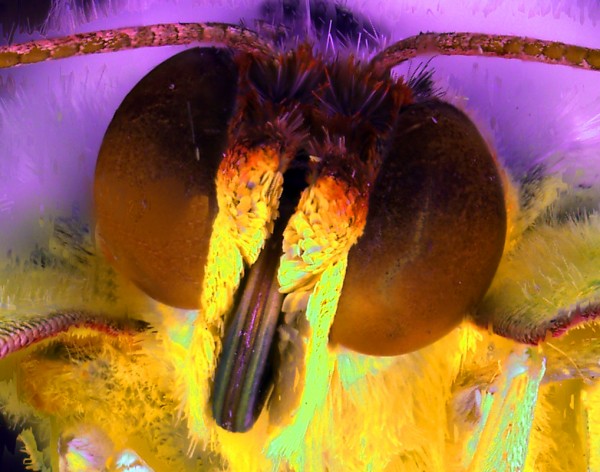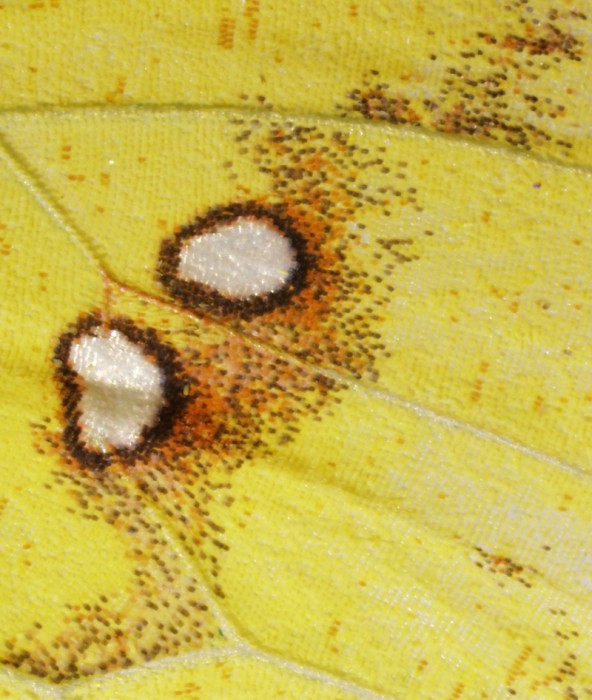Order: Lepidoptera
Family: Pieridae
Genus: Phoebis
Phoebis sennae, is commonly called the cloudless sulphur. It belongs to the Order Lepidoptera (butterflies and moths), an Order of more than 11,500 species in the United States and Canada (1). Lepidoptera means “scaly wings” in reference to the often colorful scales that cover their wings (1). Butterflies have a long coiled proboscis, which is uncoiled for feeding. At rest the coiled proboscis is held between the labial palps, as shown in the photograph of the P. sennae head (1). Members of Lepidoptera undergo complete metamorphosis and are well known for their larvae being caterpillars, which often are larger in mass and have a different feeding habit than the winged adults. Adults use their proboscis to eat nectar, while caterpillars feed on leaves with other mouthparts. Many Lepidoptera larvae form simple pupae (singular pupa) that are cocoon-like, while others including butterflies form more elaborate pupae known as chyrsalids (singular chrysalis) (1). Winged adults emerge out of these pupae. P. sennae is a member of the family Pieridae (whites and sulhpurs) and the subfamily Coliadinae (sulphurs) (2). There are 63 species of Pieridae in North America (1). Pieridae are medium-sized butterflies that are white or yellowish to orange in color and often have black markings on the margins of the wings (1). North American Pieridae prefer legumes (Fabaceae) or crucifers (Brassicaceae) as host species for the larva and pupa stages, often selecting plants within a single genus (2). P. sennae prefer herb and shrub Fabacae in the genus Cassia (cassias) or Phaseolus(beans) as host plants where they lay eggs (3). P. sennae is a strong yearly migrant, migrating north each spring and south in the fall (3). It is a widespread species whose range extends from Maine to Argentina (3). Females of this species vary in color from yellow to orange-yellow to off-white (3). Males generally are smaller than females and are always yellow (4). P. sennae exhibit some interesting mating behaviors. Unreceptive females raise their abdomens to reject courting males (3). After accepting a male and following copulation, males often fly away with females dangling behind (3). P. sennae migration has been extensively studied in Florida (5) and the off the coast of Colombia (4). Following migrating P. sennae males and females in a boat, Syrgley (4) noticed that females decreased their overall flight velocity when in a tailwind, perhaps to save energy. By contrast, males continued to fly rapidly, perhaps in order to reach the mating areas more quickly and be ready to mate with arriving females. This specimen was netted feeding on flowers outside the Bryan Center parking lot behind Duke Chapel, and was pinned and dried before photographing.

Phoebis sennae – Cloudless Sulphur dorsal view

Phoebis sennae – ventral view

Phoebis sennae – Close up of head

Phoebis sennae – Dorsal wing spot

Phoebis sennae – Ventral wing spot
Phoebis sennae on Bugguide.net
Phoebis sennae on Wikipedia
Phoebis sennae additional photographs
Phoebis sennae on Butterfliesandmoths.org
Sources
(2) Opler, P.A., A Field Guide to Eastern Butterflies, Ed. R.T. Peterson, (1998), Houghton Mifflin, Plate 10, Viewed on Amazon.com “Look Inside” 9 Oct. 2008.
(3) Scott, J.A., The Butterflies of North America, (1992), Stanford University Press, Viewed on Amazon.com “Look Inside” 9 Oct. 2008.
(4) Syrgley, R.A., Sexual differences in tailwind drift compensation in Phoebis sennae butterflies (Lepidoptera: Pieridae) migrating over seas, Behavioral Ecology, vol. 12, (2001), pp. 607-611.
(5) Walker, T.J., Butterfly migrations in Florida: Seasonal patterns and long-term changes, Population Ecology, vol. 30, (2001), pp. 1052-1060.
